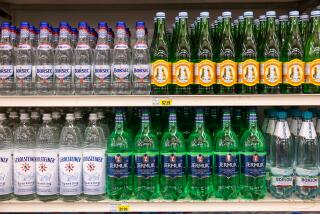In This Case, Product Is Tasteless and the Advertisements Have Class : Marketing: The vodka wars heat up with the introduction of new brands and extremely heavy spending for the older ones, especially the imports.
- Share via
Rarely has something so tasteless prompted so many claims of class.
In the past year, at least 10 new labels of pricey imported vodka, shipped from such places as Iceland, Denmark, Poland and Norway, have swamped bar shelves and liquor stores. One upper-crust brand, Denaka, insists that it “stands out” from the rest. Another, Icy, swears it is an “absolute improvement,” taking a swipe at its famous competitor, Absolut.
None, of course, mentions the fact that vodka, no matter how high-priced, is conspicuously devoid of taste. Instead, each new marketer is stressing its vodka’s smoothness as well as the cachet of an exotic country. “It’s like nuclear proliferation,” said Tom Pirko, president of Bevmark Inc., a Los Angeles-based food and beverage consulting company. “Everyone is racing to build the biggest bomb.”
And what a race it is. Newcomers to the $240-million imported-vodka market--roughly 8% of total U.S. vodka sales--are pouring millions of dollars into ad campaigns that take potshots at No. 1 import Absolut, a Swedish vodka distributed by Carillon Importers Ltd. of Teaneck, N.J., that lays claim to roughly 60% of imported vodka sales.
Absolut is countering with lavish magazine advertisements, including an eight-page layout in Vogue that features designer clothing made especially for Absolut. On another front, Absolut fired off a lawsuit against a rival vodka importer to stop a parody of the long-running Absolut ad campaign.
Imported vodka is one of the few growth areas in a steadily declining liquor industry. Hard-liquor sales, after seven years of stagnation, dipped 2% in 1988 and a similar decline is expected this year, according to M. Shanken Communications Inc., which publishes several beverage-industry publications. Prompting the decline is a health-conscious America’s diminishing taste for whiskey and other so-called “brown goods”: From 1987 through 1988, total U.S. whiskey sales dropped 3.2%, according to Jobson Beverage Alcohol Group, another publisher of liquor trade magazines.
Meanwhile, sales of premium-priced vodka jumped an average of 24% each year from 1980 through 1988, exploding during that period from 500,000 cases to 3.2 million cases, Shanken reported. While imports make up only 8% of total vodka sales, their galloping growth has driven overall vodka sales from 18.8% of total spirits sales in 1980 to 21.4% last year.
With drinkers willing to pay $5 to $8 more per bottle for the imported stuff, observers say manufacturers and distributors are earning up to $50 per premium-vodka case--a nice profit margin by liquor-industry standards. For example, a 750-milliliter bottle of Smirnoff, the leading domestic vodka, retails in New York for roughly $8, contrasted with about $12 a bottle for Absolut.
However, Absolut isn’t about to give up its No. 1 spot without a fight. The Carillon brand upped its $20-million ad budget by an estimated 25% this year, and the extra money will help increase the number of magazines carrying Absolut’s consistently lavish and groundbreaking magazine advertisements.
Since the early 1980s, the brand’s expensive ads have earned it widespread attention in magazine and newspaper articles, helping Absolut go from 5,000 cases in 1979 to an estimated 2.5 million in 1989.
Typifying its use of the spectacular, Absolut surprised Vanity Fair readers this month with an ad in which a “voice” wished them “Merry Christmas” in English, Italian and Spanish when they opened the magazine. Employing a tiny, battery-operated computer chip, the ad cost about $1 million to produce. That expense, along with Absolut’s other lavish promotions, eventually shows up in the price. Said one industry consultant, “They have to make at least $5 a case just to cover advertising spending.”
Other brands looking for a toehold have launched direct assaults on Absolut. Louisville, Ky.-based Brown-Forman Corp. last winter ushered in Icy, an import from Iceland, with a blatantly derivative trade-advertising campaign featuring the slogan, “Absolute Improvement.” The ads so infuriated Carillon it sued for trademark infringement.
Brown-Forman has since revised the ad theme. But Denaka, a Danish vodka imported by Buckingham Wile Co., continues to allude to the leader with its print headline, “In a world of absolutes, Denaka excels.”
A bit more subtle, Tanqueray Sterling Vodka, imported from England by Schieffelin & Somerset Co. in New York and introduced nationally this year, illustrates its ads with a bottle as starkly lit as Absolut’s and an equally cocky tag-line: “At last, perfection in a vodka.”
The imperative to remain competitive is especially urgent for Palace Brands’ Finlandia, which has been around since the early 1970s and is No. 3 in the category, after Stolichnaya. The recent rash of introductions prompted the brand to come out for the first time with its own spectacular Christmas ad, breaking in New York magazine and Rolling Stone. The ad, created by Finlandia’s agency, Young & Rubicam, features a hologram of the Finlandia bottle that cost $400,000 to produce and print.
And the segment continues to grow. This year Monsieur Henri Wines Ltd., which imports Stolichnaya from the Soviet Union, extended the Stoli brand name by launching high-end and low-end Soviet imports--Stolichnaya Cristall and Priviet, respectively. Cristall retails for about $20, contrasted with $10 for Priviet.
Another launch, Elduris from Glenmore Distilleries Co., increases to two the number of vodka imports from Iceland. And the House of Seagram plans to reintroduce Wyborowa vodka, bringing Poland into the fray. Even Smirnoff is dipping into the super-premium waters with Smirnoff Silver Private Reserve, currently being test-marketed.
More to Read
Inside the business of entertainment
The Wide Shot brings you news, analysis and insights on everything from streaming wars to production — and what it all means for the future.
You may occasionally receive promotional content from the Los Angeles Times.










